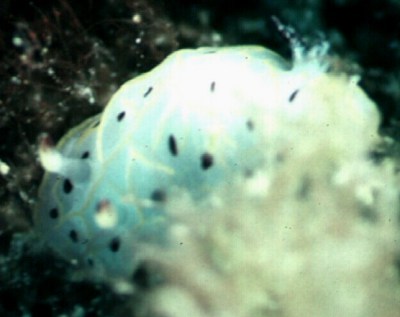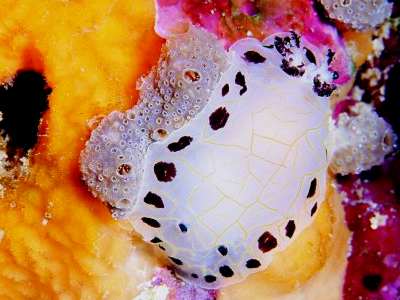
Halgerda maricola
Fahey & Gosliner, 2001
Order: NUDIBRANCHIA
Suborder: DORIDINA
Superfamily: EUDORIDOIDEA
Family: Dorididae
PHOTO
(WAMS 12318). Specimen, 17 mm, from Rottnest Island, Western Australia. 23 m depth, December, 1998. Photo by G. Gunness. (Fahey & Gosliner, 2001: Fig. 3C).
Halgerda maricola is a small species with a white background color and low ridges which havea thin yellow-orange line along the crest. There are small black spots in the spaces between the ridges and the mantle margin and foot are both lined in yellow. The rhinophores and gills are both white, with small dark splotches of color at the tips. This species is similar to Halgerda formosa. The differences between these two species include the following: H. maricola has dark pigmentation on the rhinophore tips but in H. formosa most of the rhinophore club is black, and there is a black band down the posterior of the rhinophore stalk. H. maricola has dark spots scattered all over the mantle, in the depressions while in H. formosa the dark spots seem to be confined to the mantle skirt region, apparently absent from the central part of the mantle. The tips of the gills of H. maricola are dark, but H. formosa has white gill tips. Fahey & Gosliner consider that there are also reproductive differences between these two species.
Reference:
• Fahey, S.J. & Gosliner, T.M. (2001) On the genus Halgerda (Nudibranchia: Halgerdidae) from Western Australia with descriptions of four new species. Bollettino Malacologico, 37(5-8): 55-76.
Rudman, W.B., 2001 (October 10) Halgerda maricola Fahey & Gosliner, 2001. [In] Sea Slug Forum. Australian Museum, Sydney. Available from http://www.seaslugforum.net/find/halgmari
Related messages
Halgerda maricola? from Rottnest Is, W. Australia
March 17, 2004
From: Mark Gerlach

Hi Bill,
I found this speciman on a reef near Rottnest Island, [off Perth, Western Australia].
Looks like a Halgerda? but I couldn't one with same markings in any of my books.
Depth 15m
Limestone reef
speciman size 40mm.
Cheers,
Mark.
silverthorne@bigpond.com
Gerlach, M., 2004 (Mar 17) Halgerda maricola? from Rottnest Is, W. Australia. [Message in] Sea Slug Forum. Australian Museum, Sydney. Available from http://www.seaslugforum.net/find/12251Dear Mark,
Sorry for the delay in answering this but I have been trying to get a name for you without success. It has some similarities to Halgerda maricola, which was described from Rottnest Island. That species has very low ridges with a narrow yellow line along the edge, just like your animal, but in that species there is a black spot in ech of the 'valleys' between the yellow ridges, and there are no large black spots around the mantle edge, while your animal has the opposite. In Halgerda maricola there is also a thin yellow line at the edge of the mantle and the foot. I can't see either in your photo so if you have other photos could you check what the edge of the foot and the mantle looks like?
So very tentatively I am calling it H. maricola but I am probably wrong. There is one other possibility, and that is that both this animal and the photo of 'true' H. maricola are colour forms of Halgerda wasinensis. I have recently discussed that species [message #11828] and suggested it has quite a colour shift across the Indian Ocean. If that is so then your photo here looks very similar to one in an earlier message [#8905] from the Similan Ids, Andaman Sea, and the photo of typical Halgerda maricola from Rottnest Island [#5476] looks very like photos from Mayotte [#11477] of a spotted form of H. wasinensis.
So basically the best I can say is that your animal is interesting, and it would be useful to look our for other similar coloured animals.
Best wishes
Bill Rudman
Information on Halgerda maricola
October 16, 2001
From: Shireen Fahey

Dear Bill,
Here is some information on, Halgerda maricola, one of the new species of Halgerda that Terry Gosliner and I have just published.
PHOTO: (WAMS 12318). Specimen, 17 mm, from Rottnest Island, Western Australia. 23 m depth, December, 1998. Photo by G. Gunness. (Fahey & Gosliner, 2001: Fig. 3C).
Halgerda species aren't the most common nudibranch genus on the reefs, but Halgerda maricola is even harder to find. It's a very small species and it likes to hide among the rich substrate off Rottnest Island in Western Australia. This species was named for a very avid diver and photographer, Mary Gudgeon, the namesake of Mary's Reef on the northeast side of Rottnest. Halgerda maricola has a white background color with low ridges that have thin orange crests. There are small black dots in the concavities of the ridges and the mantle margin and foot are both lined in yellow. The rhinophores and gill are both white, with small dark splotches of color at the tips. This species is most similar to Halgerda formosa. The differences between these two species include the following: H. maricola has dark pigmentation on the rhinophore tips but H. formosa has dark coloration on the stalks too. H. maricola has dark spots on the dorsum that are confined to the ridge depressions, but H. formosa has randomly scattered dark spots. The tips of the gills of H. maricola are dark, but H. formosa has white gill tips. The reproductive differences also separate these two species.
Reference:
• Fahey, S.J. & Gosliner, T.M. (2001) On the genus Halgerda (Nudibranchia: Halgerdidae) from Western Australia with descriptions of four new species. Bollettino Malacologico, 37(5-8): 55-76.
Best wishes,
Shireen
sfahey@mailbox.uq.edu.au
Fahey, S., 2001 (Oct 16) Information on Halgerda maricola. [Message in] Sea Slug Forum. Australian Museum, Sydney. Available from http://www.seaslugforum.net/find/5476Thanks Shireen,
Bill Rudman
